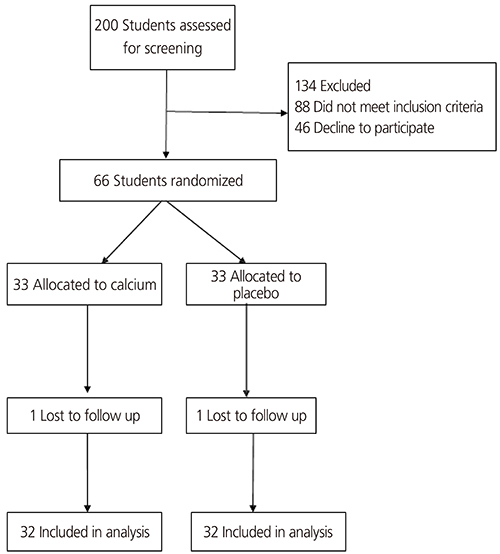Obstet Gynecol Sci.
2017 Jan;60(1):100-105. 10.5468/ogs.2017.60.1.100.
Effect of calcium on premenstrual syndrome: A double-blind randomized clinical trial
- Affiliations
-
- 1Maternal and Child Care Research Center, Hamadan University of Medical Sciences, Hamadan, Iran.
- 2Department of Midwifery, Tuyserkan Branch, Islamic Azad University, Tuyserkan, Iran. e.jenabi@yahoo.com
- 3Department of Medical Entomology, School of Medicine, University of Medical Sciences, Hamadan, Iran.
- KMID: 2383215
- DOI: http://doi.org/10.5468/ogs.2017.60.1.100
Abstract
OBJECTIVE
Premenstrual syndrome (PMS) affects millions of women and is known as the most important disorder among them. The very aim of the present study was to evaluate the effects of low dose calcium on severity of PMS.
METHODS
This study can be considered as a double-blind randomized clinical trial. Female students of Hamadan University of Medical Sciences diagnosed with PMS in 2014 participated in the present study. Sixty-six female students diagnosed with PMS were involved in the experimental and control groups. The participants were randomly assigned into two groups to receive 500 mg of calcium daily or placebo for two months. Severity of PMS was detected by Daily Record of Severity of Problems, which was used to measure symptoms during one menstrual cycle before and two menstrual cycles after the intervention.
RESULTS
No signifcant differences were observed in the mean scores of PMS symptoms between calcium and placebo groups before the treatment (P=0.74). However, signifcant differences were noticed between the two intervention groups in the first (P=0.01) and second menstrual cycles (P=0.001) after the intervention. The differences were significant in subgroups of anxiety, depression, emotional changes, water retention, and somatic changes in calcium group compared with placebo group in the menstrual cycle before the intervention and two menstrual cycles after the intervention and among menstrual cycles (0, cycle 1, cycle 2) in calcium group (P=0.01).
CONCLUSION
Overall, the results of the present study suggest that treatment with calcium supplements is an effective method for reducing mood disorders during PMS.
MeSH Terms
Figure
Cited by 1 articles
-
A systematic review of the role of vitamin D and calcium in premenstrual syndrome
Fatemeh Abdi, Gity Ozgoli, Fatemeh Sadat Rahnemaie
Obstet Gynecol Sci. 2019;62(2):73-86. doi: 10.5468/ogs.2019.62.2.73.
Reference
-
1. Fathizadeh N, Ebrahimi E, Valiani M, Tavakoli N, Yar MH. Evaluating the effect of magnesium and magnesium plus vitamin B6 supplement on the severity of premenstrual syndrome. Iran J Nurs Midwifery Res. 2010; 15:Suppl 1. 401–405.2. Khajehei M, Abdali K, Parsanezhad ME, Tabatabaee HR. Effect of treatment with dydrogesterone or calcium plus vitamin D on the severity of premenstrual syndrome. Int J Gynaecol Obstet. 2009; 105:158–161.3. Thys-Jacobs S, Starkey P, Bernstein D, Tian J. Calcium carbonate and the premenstrual syndrome: effects on premenstrual and menstrual symptoms. Premenstrual Syndrome Study Group. Am J Obstet Gynecol. 1998; 179:444–452.4. Ghanbari Z, Haghollahi F, Shariat M, Foroshani AR, Ashrafi M. Effects of calcium supplement therapy in women with premenstrual syndrome. Taiwan J Obstet Gynecol. 2009; 48:124–129.5. Freeman EW. Therapeutic management of premenstrual syndrome. Expert Opin Pharmacother. 2010; 11:2879–2889.6. Chocano-Bedoya PO, Manson JE, Hankinson SE, Johnson SR, Chasan-Taber L, Ronnenberg AG, et al. Intake of selected minerals and risk of premenstrual syndrome. Am J Epidemiol. 2013; 177:1118–1127.7. Salamat S, Ismail KM, O'Brien S. Premenstrual syndrome. Obstet Gynecol Reprod Med. 2008; 18:29–32.8. Abraham GE. Nutritional factors in the etiology of the premenstrual tension syndromes. J Reprod Med. 1983; 28:446–464.9. Shobeiri F, Jenabi E. The effects of vitamin E on muscular pain reduction in students affected by premenstrual syndrome. Iran J Obstet Gynecol Infertil. 2014; 17:1–5.10. Shobeiri F, Oshvandi K, Nazari M. Clinical effectiveness of vitamin E and vitamin B6 for improving pain severity in cyclic mastalgia. Iran J Nurs Midwifery Res. 2015; 20:723–727.11. Shamberger RJ. Calcium, magnesium, and other elements in the red blood cells and hair of normals and patients with premenstrual syndrome. Biol Trace Elem Res. 2003; 94:123–129.12. Akhlaghi F, Hamedi A, Javadi Z, Hosseinipoor F. Effects of calcium supplementation on premenstrual syndrome. Razi J Med Sci. 2004; 10:669–675.13. Kermani AZ, Taavoni S, Hosseini AF. Effect of combined calcium and vitamin E consumption on premenstrual syndrome. Iran J Nurs. 2010; 23:8–14.14. Masoumi SZ, Ataollahi M, Oshvandi K. Effect of combined use of calcium and vitamin B6 on premenstrual syndrome symptoms: a randomized clinical trial. J Caring Sci. 2016; 5:67–73.15. Ebrahimi E, Khayati Motlagh S, Nemati S, Tavakoli Z. Effects of magnesium and vitamin b6 on the severity of premenstrual syndrome symptoms. J Caring Sci. 2012; 1:183–189.16. Ghanbari Z, Manshavi FD, Jafarabadi M. The effect of three months regular aerobic exercise on premenstrual syndrome. J Family Reprod Health. 2008; 2:167–171.17. Penland JG, Johnson PE. Dietary calcium and manganese effects on menstrual cycle symptoms. Am J Obstet Gynecol. 1993; 168:1417–1423.
- Full Text Links
- Actions
-
Cited
- CITED
-
- Close
- Share
- Similar articles
-
- Understanding and Treatment of Premenstrual Dysphoric Disorder
- Premenstrual syndrome & premenstrual dysphoric disorder
- Correspondence to editorial on “Safety and efficacy of HK-660S in patients with primary sclerosing cholangitis: A randomized double-blind phase 2a trial”
- A systematic review of the role of vitamin D and calcium in premenstrual syndrome
- A novel clinical trial for primary sclerosing cholangitis from Asia: All regional endeavors should improve global management of primary sclerosing cholangitis: Editorial on “Safety and efficacy of HK-660S in patients with primary sclerosing cholangitis: A randomized double-blind phase 2a trial”


